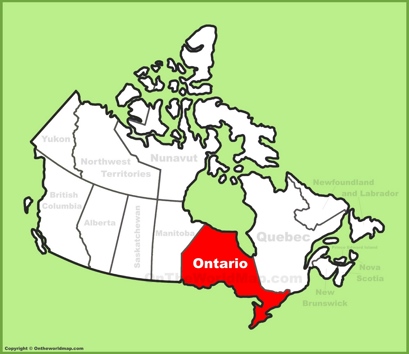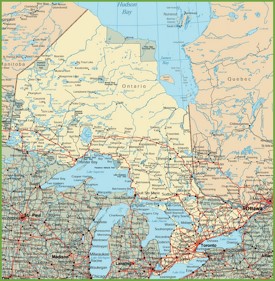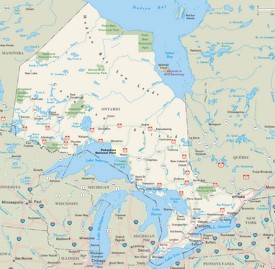Ontario Map
Description:
This map shows cities, towns, province capital, rivers, lakes, highways, and major roads in Ontario.
Size: 1250x1288px / 513 Kb
Author: Ontheworldmap.com
You may download, print or use the above map for educational, personal and non-commercial purposes. Attribution is required. For any website, blog, scientific research or e-book, you must place a hyperlink (to this page) with an attribution next to the image used.
Online Map of Ontario
About Ontario
Ontario stands as Canada's most populous province and serves as the nation's economic engine. Located in central Canada, the province occupies 1,076,395 square kilometers (415,598 square miles), making it the second-largest province after Quebec. As of 2025, Ontario's population reaches approximately 16.2 million people, representing more than one-third of Canada's total population.
The province borders Manitoba to the west and Quebec to the east. Ontario shares extensive borders with the United States to the south, including the states of Minnesota, Michigan, Ohio, Pennsylvania, and New York. These boundaries primarily follow natural features, including the Great Lakes—Superior, Huron, Erie, and Ontario—and the St. Lawrence River.
Toronto, Ontario's capital and Canada's largest city, houses approximately 2.8 million residents within the city proper and over 6.2 million in the Greater Toronto Area. The city functions as Canada's financial center and drives much of the province's economic activity. Ottawa, Canada's national capital, also resides within Ontario's borders. Other major urban centers include Mississauga, Brampton, Hamilton, London, and Windsor, each contributing significantly to the province's diverse economy.
Ontario generates 37 percent of Canada's national GDP and leads the country in industrial production, accounting for 52 percent of national manufacturing output. The economy demonstrates remarkable diversity across multiple sectors. Automotive manufacturing concentrates in Windsor and Oshawa, while the technology corridor between Toronto and Waterloo has emerged as a major North American innovation hub. The province excels in financial services, biotechnology, pharmaceuticals, and information technology. Mining operations in the Sudbury region produce two-thirds of Canada's nickel and one-third of its copper. The service sector employs 79 percent of Ontario's workforce, reflecting the province's transition to a knowledge-based economy.
Tourism thrives throughout Ontario, attracting millions of visitors annually. Niagara Falls, the province's most iconic natural attraction, draws tourists from around the world to witness the spectacular cascade along the Canada-US border. In Toronto, the CN Tower rises 553 meters above the city, offering panoramic views from its observation decks and glass floor. Casa Loma, a Gothic Revival castle built between 1911 and 1914, provides visitors with a glimpse into early 20th-century grandeur. The Royal Ontario Museum houses 18 million artifacts spanning art, world culture, and natural history. In Ottawa, Parliament Hill showcases Gothic Revival architecture and serves as the symbolic heart of Canadian democracy. The Toronto Islands, accessible by ferry, offer beaches, parks, and recreational activities just minutes from downtown Toronto.
The Facts:| Capital: | Toronto |
| Largest city: | Toronto |
| Population (Q3 2025): | 16,258,260[1] |
| Area: | 415,598 sq mi (1,076,395 sq km) |
| Density: | 41.3/sq mi (15.94/sq km) |
| Official languages: | English |
| Coordinates: | 49°15′N 84°30′W |
| Gross domestic product (Total - 2024): | CA$1,178.092 billion |
| Gross domestic product (Per capita - 2024): | CA$73,064 |
| Time zone: |
East of 90th meridian west - UTC−05:00 (EST) - Summer (DST) - UTC−04:00 (EDT) West of 90th meridian west, except Atikokan and Pickle Lake - UTC−06:00 (CST) - Summer (DST) - UTC−05:00 (CDT) Atikokan and Pickle Lake (No DST) - UTC−05:00 (EST) |
| Canadian postal abbr.: | ON |
| Postal code prefix: | K, L, M, N, and P |
| ISO 3166 code: | CA-ON |
| Flower: | White trillium |
| Tree: | Eastern white pine |
| Bird: | Common loon |
| Official Website: | www.ontario.ca |
Google Map of Ontario
List of Cities in Ontario
- Toronto
- Ottawa
- Mississauga
- Brampton
- Hamilton
- London
- Markham
- Vaughan
- Kitchener
- Windsor
- Oakville
- Richmond Hill
- Burlington
- Oshawa
- Sudbury
- Barrie
- Guelph
- Cambridge
- St. Catharines
- Kingston
- Waterloo
- Thunder Bay
- Brantford
- Pickering
- Niagara Falls
- Peterborough
- Kawartha Lakes
- Sault Ste. Marie
- Sarnia
- Norfolk County
- Welland
- Belleville
- North Bay
- Haldimand County
- Cornwall
- Woodstock
- Quinte West
- St. Thomas
- Timmins
- Brant
- Orillia
- Stratford
- Clarence-Rockland
- Prince Edward County
- Thorold
- Brockville
- Owen Sound
- Port Colborne
- Kenora
- Pembroke
- Elliot Lake
- Temiskaming Shores
- Dryden
Main sights in Ontario
- Niagara Falls
- CN Tower
- Royal Ontario Museum
- Thousand Islands
- Casa Loma
- Art Gallery of Ontario
- Ripley's Aquarium
- Toronto Islands
- Hockey Hall of Fame
- Distillery District
- Kensington Market
- Bata Shoe Museum
- Woodbine Beach
- Nathan Phillips Square
- Fort York
- St. Lawrence Market
- Toronto Zoo
- Yonge-Dundas Square
- Canada's Wonderland
- Scarborough Bluffs
- Algonquin Provincial Park
- Ontario Science Centre
- High Park
- Parliament Hill in Ottawa
- Rideau Canal
- Rogers Centre
- Scotiabank Arena
- Royal Botanical Gardens
- Blue Mountain Resort
- Bruce Peninsula National Park
Major Rivers of Ontario
- Ottawa River - 1,271 mi (2,045 km)
- Saint Lawrence River - 1,197 mi (1,927 km)
- Albany River - 982 mi (1,580 km)
- Severn River - 982 mi (1,580 km)
- Winnipeg River - 813 mi (1,308 km)
- Attawapiskat River - 748 mi (1,204 km)
- English River - 615 mi (990 km)
- Winisk River - 475 mi (765 km)
- Moose River - 440 mi (708 km)
- Abitibi River - 340 mi (547 km)
- Missinaibi River - 325 mi (523 km)
- Mattagami River - 310 mi (499 km)
- Grand River - 280 mi (451 km)
- Thames River - 273 mi (440 km)
- Spanish River - 213 mi (343 km)
- French River - 110 mi (177 km)
- Credit River - 90 mi (145 km)
- Humber River - 73 mi (118 km)
- Don River - 38 mi (61 km)
- Niagara River - 36 mi (58 km)
List of the Largest Lakes of Ontario
- Lake Superior - 31,700 sq mi (82,100 km2)
- Lake Huron - 23,000 sq mi (59,600 km2)
- Lake Erie - 9,910 sq mi (25,700 km2)
- Lake Ontario - 7,340 sq mi (19,000 km2)
- Lake Nipigon - 1,872 sq mi (4,848 km2)
- Lake of the Woods - 1,220 sq mi (3,150 km2)
- Lac Seul - 640 sq mi (1,657 km2)
- Lake St. Clair - 430 sq mi (1,114 km2)
- Rainy Lake - 360 sq mi (932 km2)
- Lake Abitibi - 359 sq mi (931 km2)
- Lake Nipissing - 321 sq mi (832 km2)
- Lake Simcoe - 287 sq mi (744 km2)
- Big Trout Lake - 255 sq mi (661 km2)
- Sandy Lake - 203 sq mi (527 km2)
- Lake St. Joseph - 190 sq mi (493 km2)
- Lake Muskoka - 120 sq mi (311 km2)
- Lake Rosseau - 63 sq mi (163 km2)
- Lake Joseph - 51 sq mi (132 km2)
- Lake Temagami - 46 sq mi (120 km2)
- Lake Wanapitei - 44 sq mi (114 km2)
References
1. ^ Population estimates, quarterly. Statistics Canada.Maps of Canada
Provinces and Territories
Cities of Canada
Cities of Canada







